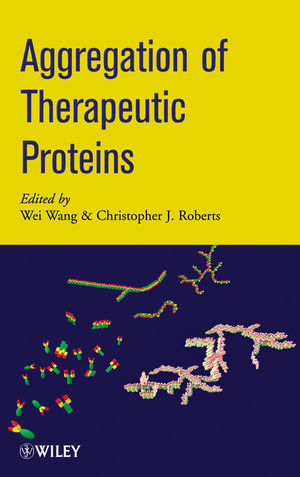Aggregation of Therapeutic ProteinsISBN: 978-0-470-41196-4
Hardcover
484 pages
August 2010
 This is a Print-on-Demand title. It will be printed specifically to fill your order. Please allow an additional 15-20 days delivery time. The book is not returnable.
|
||||||
Preface xvii
Contributors xxi
1. Fundamental Structures and Behaviors of Proteins 1
Jennifer S. Laurence and C. Russell Middaugh
1.1 The Problem of Protein Aggregation 1
1.2 Parallels to Protein Folding 11
1.3 Views of Protein Stability and Aggregation 12
1.4 Models of Aggregation 22
1.5 Models of Protein Folding 29
1.6 Influences of Chemical Alteration on Aggregation 40
1.7 Approaches to Predicting Aggregation 46
1.8 Conclusions 49
References 50
2. Protein Aggregation Pathways, Kinetics, and Thermodynamics 63
Yi Li and Christopher J. Roberts
2.1 Introduction 63
2.2 Native and Nonnative Aggregation Pathways 66
2.3 Thermodynamics of Reversible Self-Association 69
2.4 Aggregation Kinetics and Distinguishing Kinetic Pathways 75
2.5 Chemical Modifications 80
2.6 Effects of Cosolvents or Cosolutes 82
Appendix—Derivation of t32 for van der Waals (vdW) Mixture 94
Acknowledgments 97
References 97
3. Identification and Impact of Aggregation-Prone Regions in Proteins and Therapeutic Monoclonal Antibodies 103
Sandeep Kumar, Xiaoling Wang, and Satish K. Singh
3.1 Introduction 103
3.2 Energy Landscapes, Protein Folding, and Aggregation 105
3.3 Prediction of APRs in Proteins and Biotherapeutics 106
3.4 Conclusions and Future Directions 114
Acknowledgments 115
References 115
4. External Factors Affecting Protein Aggregation 119
Wei Wang, Ning Li, and Stan Speaker
4.1 Introduction 119
4.2 Protein Aggregation Pathways 120
4.3 Effects of Temperature 132
4.4 Effects of Solution Conditions and Composition on Protein Aggregation 136
4.5 Effects of Processing Steps on Protein Aggregation 164
4.6 Effects of Solid-State Condition and Composition on Protein Aggregation 174
4.7 Summary 177
Acknowledgment 178
References 178
5. Experimental Detection and Characterization of Protein Aggregates 205
Vikas K. Sharma and Devendra S. Kalonia
5.1 Introduction 205
5.2 Aggregate Classifi cation 206
5.3 Analytical Tools for the Characterization of Aggregates 212
5.4 Summary 246
References 247
6. Approaches to Control Protein Aggregation during Bulk Production 257
Linda O. Narhi, Yijia Jiang, Rohini Deshpande, Sohye Kang, and Joseph Shultz
6.1 Introduction 257
6.2 Candidate Selection 257
6.3 Protein Aggregation and Cell Culture 269
6.4 Protein Aggregation and Purifi cation 271
6.5 Summary 295
References 295
7. Protein Aggregation and Particle Formation: Effects of Formulation, Interfaces, and Drug Product Manufacturing Operations 301
Hanns-Christian Mahler, Stefan Fischer, Theodore W. Randolph, and John F. Carpenter
7.1 Introduction 301
7.2 Roles of Conformational and Colloidal Stability in Reducing Rates of Aggregation 302
7.3 Effects of Interfaces on Protein Aggregation 305
7.4 Critical Processing Steps during Drug Product Manufacturing of Biopharmaceuticals 310
7.5 Particles in Parenteral Products and Visible Inspection 316
7.6 Summary and Outlook 324
References 325
8. Approaches to Managing Protein Aggregation in Product Development 333
Wei Wang and Nicholas W. Warne
8.1 Introduction 333
8.2 Approaches in Formulation Development 334
8.3 Protection of Proteins in Various Processing Steps 345
8.4 Aggregation Control by Structural Modifi cations 351
8.5 Summary 353
References 354
9. Case Studies Involving Protein Aggregation 367
Rahul S. Rajan, Tiansheng Li, and Tsutomu Arakawa
9.1 Introduction 367
9.2 Case Study 1: Aggregation in the Liquid State: The Role of Osmolytes in Stabilizing KGF toward Aggregation 368
9.3 Case Study 2: Aggregation in the Liquid State: Heterogeneity and Non-Linearity in IgG2 Aggregation
during Long-Term Storage 376
9.4 Case Study 3: Aggregation in the Frozen State: The Role of Excipient Crystallization 381
9.5 Case Studies 4 and 5: Aggregation in the Lyophilized State: Role of Residual Moisture and Mechanisms
of Excipient Stabilization 385
9.6 Case Study 6: Protein Particulation Due to Nucleation by Foreign Material in Fill/Finish Manufacturing Operations 391
9.7 Overall Discussion 394
Acknowledgments 396
References 396
10. Aggregation and Immunogenicity of Therapeutic Proteins 403
Vasco Filipe, Andrea Hawe, Huub Schellekens, and Wim Jiskoot
10.1 Introduction 403
10.2 Immunogenicity of Therapeutic Proteins 404
10.3 Immune Mechanisms Related to Protein Immunogenicity 409
10.4 Aggregates and Immunogenicity 415
10.5 Conclusions 427
References 428
11. Regulatory Perspective on Aggregates as a Product Quality Attribute 435
Wendy C. Weinberg, Linan Ha, Susan L. Kirshner, and Daniela I. Verthelyi
11.1 Introduction 435
11.2 An Overview of the Regulatory Process 436
11.3 Product Aggregates and Safety Concerns 438
11.4 The Assessment of Aggregates: Regulatory Approaches to Controlling Product Aggregation 440
11.5 Future Challenges 446
11.6 Summary 447
Acknowledgments 447
Disclaimer 447
References 448
Index 453



